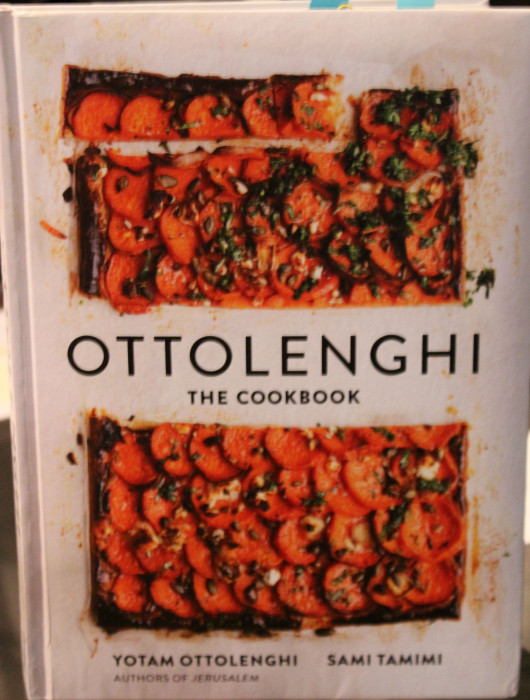You might have seen Plenty in 2011. And surely you saw Jerusalem published in late 2012. Jerusalem has become a cult cookbook akin to Around My French table.
What you probably have not seen before is the first book by Yotam Ottolenghi and Sami Tamimi. That book, Ottolenghi: The Cookbook, was published in Great Britain in 2008. Now, thanks to Ten Speed Press, that first impressive volume is available to the American audience.
Ottolenghi is as exceptional as its siblings and should be added to your cookbook collection. Most of us do not regularly eat in Middle Eastern restaurants or sample cookbooks from that region. The names of dishes and ingredients alone can be mysterious to us. The combinations can give us pause. You can cook this with that?
Yes, you can. Ottolenghi proves, with every recipe, that culinary surprises and pleasures are just a few steps away. The regional dishes here, often presented with lovely close up shots, are traditional treasures ready for us to incorporate into our lives:
- Cucumber and Poppy Seed Salad
- Grilled Cauliflower with Tomato, Dill and Capers
- Roasted Butternut Squash with Burnt Eggplant and Pomegranate Molasses
- Sardines Stuffed with Bulgur, Currants and Pistachios
Suzen has already prepared two of the dishes here: Koseri a rice and lentil dish and Beef and Lamb Meatballs Cooked in Tahini. We made these two the centerpiece for a dinner party that had everyone returning for seconds. The dishes in Ottolenghi are very likely to become part of your “regular recipe rotation.” You’ll find these recipes in the blogs here on the next two days.
Authors Ottolenghi and Tamimi have an entwined history. Both were born in Jerusalem, one Israeli and one Palestinian. Both migrated to London for education and there to discover their passion for food. They met on a London street, they formed a friendship and then a partnership. The result is history for them and important food contributions for us.
And not just Middle Eastern food. These men are not shy and have embraced the cooking of the Western world just as much as they invite us to their native cuisine. They like sweets. I had to chuckle when I read the half page devoted to how to cook a brownie to achieve that they believe to be the proper texture. Two guys from Jerusalem describing the right level of gooiness and how to measure it? There are, it turns out, real benefits from globalization.
Some of the desserts combine both Western and Middle Eastern flavors into one lovely extravaganza. For example, they offer their Apple and Olive Oil Cake with Maple Icing. Imagine palm trees growing in Maine.
Perhaps that is the essence of this important book: imagination. Suzen and I are planning much of our Thanksgiving feast from this book. That apple cake, a lovely Sweet Potato Gratin, the grilled cauliflower. And for the day after Thanksgiving, they have Turkey and Corn Meatballs with Roasted Red Pepper Sauce. How can you say no to that?
Whatever your culture. Whatever your food preferences, if you page through Ottolenghi then somewhere you will pause. You will wonder just what that dish must taste like. And probably you’ll be gracefully seduced into cooking from Ottolenghi. I was.


I’m anxious to take a look at this cookbook while browsing at Barnes & Noble this week-thanks for sharing – the recipes sound amazing and I bet the pictures will be gorgeous